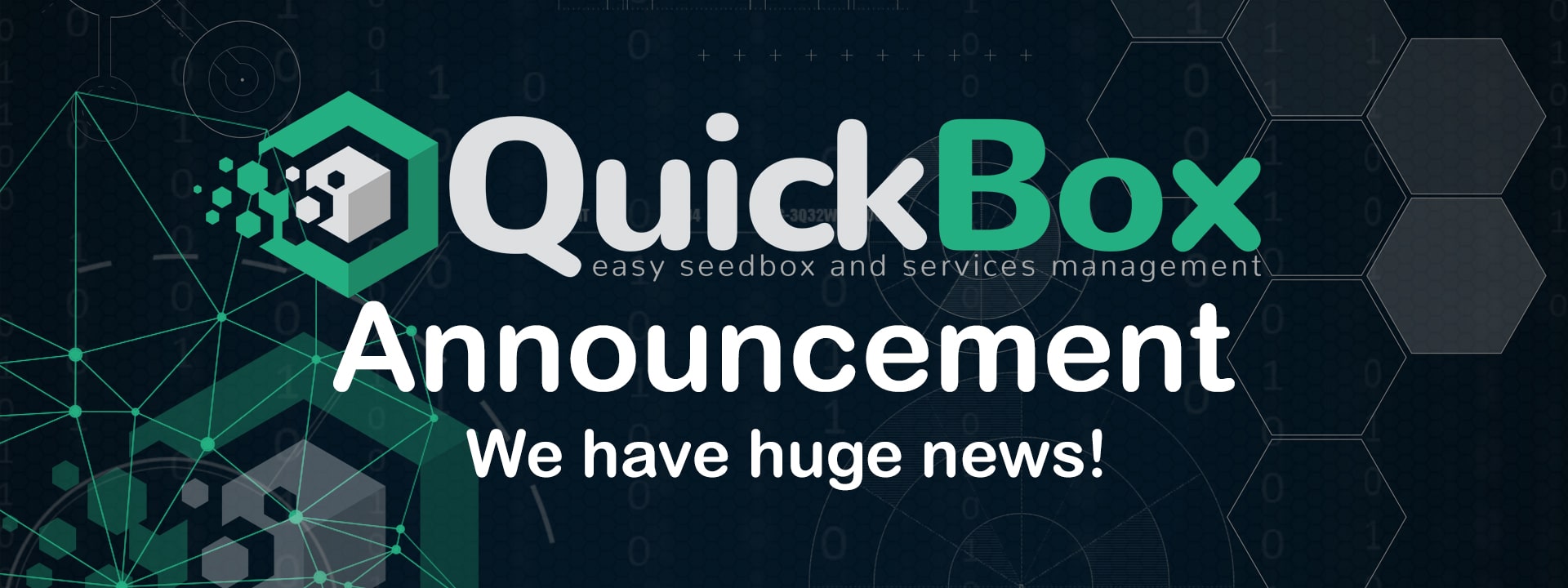Hello Everyone!
Over on Discord, we had a request for me to create an in-depth guide into my QuickBox setup, and how I use QuickBox for my needs. Not only will I be going into each application that I use, I’ll also talk about the setup of each, and how I (try) and automate a lot of tasks.
In addition, I had to completely rebuild my server due to some issues that I was having and so I feel now is the perfect opportunity to discuss my server setup in depth as I’ve just gone through it.
Disclosure
I will be talking about various pieces of software and in no way is this post sponsored or endorsed by any of these pieces of software.
So without further ado, let’s get into the depths of my setup.
The Server
My server is one that I use from Hetzner. I have used this server for over a year now and could not be happier. It was one from an auction and I was specifically looking for something that had a lot of storage.
I currently have;
- Intel®️ Core™️ i9-9900K Octa-Core Coffee Lake (CPU Benchmark; 20,219)
- 1 Gbit connection
- 2 x 8 TB SATA Enterprise HDD 7200 rpm
- 64 GB DDR4
This does plenty for everything that I need and if you’re like me, someone who wants to horde as much data as possible, then I recommend getting a server with a lot of storage.
However, if you’re just starting out, or looking for something a little cheaper and easier, then I’d recommend 2TB-4TB worth of storage. The only downside is managing that storage space and ensuring that you don’t get to 100% disk space.
I then use puTTY to SSH into my server on my windows laptop and also WinSCP to FTP into my server.
Software
The first thing I did when rebuilding my server was complete any updates, and then installed QuickBox. QuickBox has been, and always will be my go-to piece of software for running my media server. I cannot think of anything easier and simpler to use for those who know computers, but not enough to code or use the command line interface (CLI).
After installing QuickBox I then start on the individual pieces of software. Now, lucky for me, I practice what I preach and had backups of my various pieces of software so I didn’t need to set everything up from scratch.
RClone
RClone is my life. RClone is my saviour and the best thing invented since…. well the computer? Anyway!
After installing RClone I decided to use the built-in RClone installer that now comes with QuickBox and it was as simple as pie. Going through the installer with all of the prompts and to the amazing articles as well (I wonder who wrote them…) it could not of been simpler for me.
The only issue I had with this, was editing the files to work with my existing setup, however, it was just a case of editing 3 files which worked out great.
Once I confirmed I could see everything in the correct folders, it was time to move onto the fun bit!
Download Clients
On my server I have 2 clients running, because I download 2 types of files. I use NZBGet for all of my usenet content that I download, and then I also use Deluge.
For years and years, I had used ruTorrent but after many battles, and many nights frustratingly going through log after log, I gave up in the search for something better for me.
I then found Deluge and it was a dream! Literally the best and easiest setup in the world! I couldn’t of asked for something better.
Tracker Management
Now, for all of my trackers, I don’t just put them into Sonarr & Radarr (more on this later) and hope for the best. I use Jackett as an integrator between everything.
Again, after using Jackett for many years, I know how it works and how easy it is to get everything setup for it and again, because I had a backup of this, it was super easy to get back up and running. The only thing I had to do was change the API code used in my other software.
TV Shows
I use Sonarr to handle all of my TV shows. I’ve used it for years, and I am extremely familiar with this. I tried version 3 of Sonarr and whilst it was nice, it didn’t like my version 2 backup and so I stuck with version 2.
In Sonarr I have my download clients set up as well as my trackers. In addition, I have it set up so that when something is downloaded, it then sends a message to my Discord Channel through the Connect option.
In this instance of Sonarr (yes I run 2 instances) I have only 1080p and below quality setup. This means as soon as something is released, my server is out looking for it.
Movies
Similarly for my TV Shows, I also run 2 instances of Radarr (one for 4K stuff, and the other normal) and I installed Radarr next, whilst installing my backup.
Again, I have my download clients set up, and my trackers, and my bot going to Discord as well. Then it was a matter of just letting Radarr and Sonarr do it’s thing.
In addition, I use the list functionality linked with Trakt.tv to add in new movies as they get announced, released, and added onto NetFlix etc. This means I always get the latest movies when they’re available.
Music
Not only do I have TV Shows and Movies, I also get music as well. This is where Lidarr comes in. Now, I’ve only started using Lidarr since 2019 however, it has become clear that it is in the same family as Sonarr and Radarr and it makes searching for music just as easy as the others.
Again because I had backups, it was as simple as restoring this, making a few changes to ports and API keys, and then I was back up and running.
Media Server
Now I’ve decided to put Plex here, however, it was the second thing that I installed after RClone. I installed Plex so it could start scanning the content on my server. With over 6,000 movies and 1,400 TV Shows, it normally takes about 2 days for it to finish the scan.
I also ensured that I had followed the instructions found here to ensure I wasn’t going to run into any bottlenecks or similar.
Content Management and Reporting
For requests I use Ombi as that is easy enough to setup within 5 minutes after everything has been installed. In addition, it syncs with Plex to add my users into it very quickly and easily as well so I don’t have to worry about adding people manually.
Finally, I then use Tautulli for all my reporting needs and further scripts as well. Tautulli tells me about any important updates or similar that I should be made aware of, as well as managing my users and checking to see if there are any issues that I should be aware of too.
I then various scripts to my Discord server about Plex and other things through Tautulli and Python scripts as well. This include but not limited too, User Reports for Watch Time, Restarting Notices, Maintenance notices and more.
Managing the Server on the Go
I’ve talked about this service previously and you can read the previous blogs about it, but I also then install Pulseway to help me manage the server whilst I’m away to ensure that everything is working as it should be, and allows me to run these scripts and others to ensure that the server is always running.
In addition, I also have it setup where I monitor the various pieces of software through UpTime Robot which also sends a message to Discord about any downtime too.
And that’s it! An in-depth look into my server setup, what I use and what I do to get it all up and running. So what should you take away from this? Well, there are 3 things to take away.
- Always backup the key files you use – you never know when you’ll need them
I always backup the files for Sonarr, Jackett, Radarr, RClone, Lidarr and Tautulli onto GDrive so I know when I need them, they’re there.
2. Automation is your friend – don’t work unless you have too
The only time I have to work is around once a month to clear down my storage, and search on Trakt.tv for any new TV shows I want monitored to be made available on Plex.
3. Set up your server so that you can manage it away from your computer
You never know when something might happen, and you don’t know where you’re going to be. The amount of times I’ve been stuck at work and I’ve needed to restart the server is unreal. The best thing is having a solution that allows you to do this.












